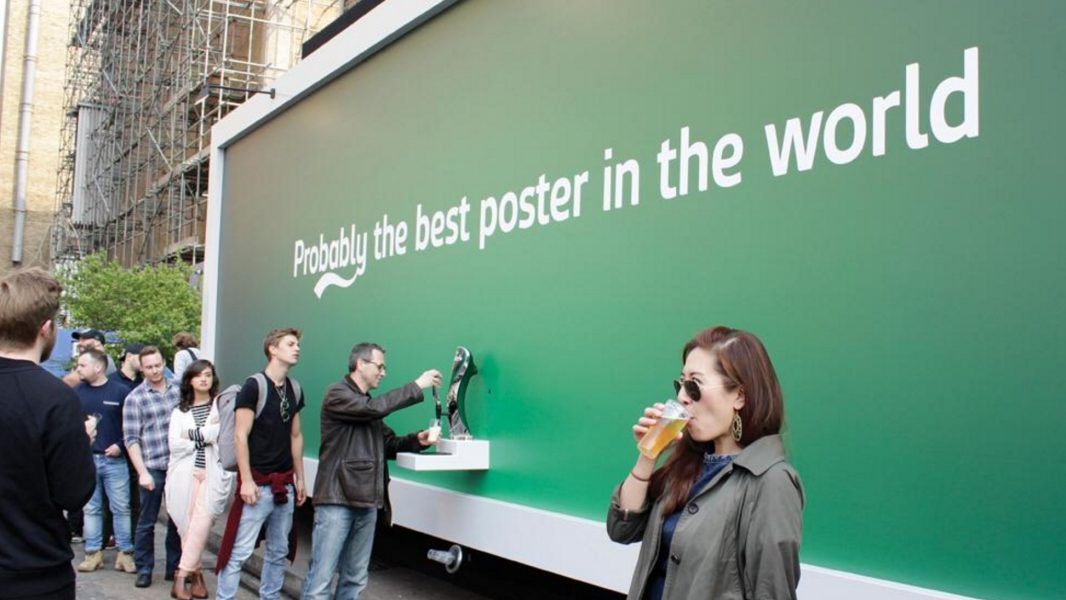4 inspiring examples of how experiential advertising engages audiences in whole new ways.
Topic
Experiential Advertising5 mins read

Experiential advertising, particularly through the use of interactive billboards and special builds, has proven to be a highly effective strategy for brands aiming to create memorable and impactful connections with consumers. This form of advertising goes beyond traditional static ads, inviting audiences to engage with the content in a more personal and often tactile manner. By leveraging the physical environment and interactive elements, brands can create a lasting impression that resonates with audiences on a much deeper level, fostering brand loyalty and driving consumer action.
The appeal of experiential advertising for brands.
Experiential advertising is effective because it transforms passive viewers into active participants. When consumers interact with a brand in a new way, they are more likely to remember the experience, share it with others and develop a positive association with the brand. This is particularly true for outdoor advertising, where the physicality and unexpectedness of the experience can disrupt the daily routine of passersby, capturing their attention in ways that traditional outdoor ads might not.
Interactive billboards and special builds – large-scale outdoor ads that often feature 3D elements or real-time engagement – are at the forefront of this trend. These installations can be seen as a blend of marketing and art, where the creativity of the design plays a crucial role in engaging the audience. As you’ll see in the examples that follow, the uniqueness of these ads lies in their ability to create a direct link between the brand and the consumer, offering an experience that is often shareable in real life and on social media.
Coca-Cola – ‘Small World Machines’.
One of the most iconic examples of effective experiential advertising is Coca-Cola’s ‘Small World Machines’ campaign. This campaign involved interactive vending machines that connected people in India and Pakistan, two countries with historically tense relations. These machines were equipped with a live streaming screen and a touch interface that allowed individuals from both countries to see and interact with each other, completing tasks together such as drawing peace symbols on the screen. This campaign not only promoted Coca-Cola as a brand that brings people together but also garnered significant media coverage and social media buzz. The interactive nature of the billboards, combined with the emotional appeal of the campaign, made it a memorable experience for participants and observers alike.
Carlsberg – ‘Probably the Best Poster in the World’.

Another successful example, and one of our all-time favourites, is Carlsberg’s ‘Probably the Best Poster in the World’. This was an interactive billboard in London that dispensed free beer directly from the poster itself. The ad featured a simple, sleek design with a tap embedded within the billboard, allowing passersby to pour themselves a free glass of Carlsberg. This innovative approach was highly effective because it offered a tangible, memorable experience that directly engaged the audience. By aligning with the brand’s world-famous slogan and giving consumers a taste of the product, the campaign generated significant buzz, social media shares and reinforced Carlsberg’s identity as a premium beer brand.
Women’s Aid – ‘Look At Me’.
Another successful example is the ‘Look at Me’ campaign by Women’s Aid in the UK. This campaign used an interactive billboard to raise awareness about domestic violence. The billboard featured the image of a bruised woman, with her injuries healing as more people looked at the ad, tracked by facial recognition technology. This powerful use of interactive technology conveyed the message that public awareness and attention can make a real difference in addressing domestic violence. The billboard was not only a striking visual but also a strong call to action, directly engaging the public in a meaningful way. The campaign was highly effective in driving awareness and conversation around the issue, as evidenced by the significant social media engagement and media coverage it received.
Northern Rail – ‘Try the Train’.

One of the most recent examples of effective experiential advertising is from UK train operator Northern Rail. As part of its broader “Try the Train” campaign, Northern launched an interactive billboard at Manchester’s bustling Oxford Road Station, aiming to encourage non-train users to give it a go. The billboard featured more than 300 tearaway tickets offering free travel for two people anywhere on the Northern network, drawing crowds eager to claim their tickets. For those who missed out, a QR code on the poster provided access to half-price tickets through Northern’s website and app, ensuring everyone had a chance to get on board. The campaign aimed to reposition the traditional train commute to attract a diverse range of commuters across the North, with the billboard design showcasing a wide array of professionals, from beauticians and tradesmen to doctors, who might not typically see themselves as commuters.
Measuring the effectiveness of experiential advertising.
The effectiveness of these campaigns can be measured in various ways, including brand recall, social media engagement and media coverage. All the campaigns above generated significant attention, often through earned media, gaining free publicity that results from people talking about the campaign in news articles, on social media and through word of mouth. This amplification effect is a key advantage of experiential advertising, as it extends the reach of the campaign beyond its physical location and duration.
As we’ve seen, interactive billboards and special builds as part of experiential advertising campaigns are highly effective for brands looking to make a lasting impact. By engaging consumers in a direct and often emotional way, these campaigns create memorable experiences that not only increase brand awareness but also foster positive associations and drive consumer action. The success of campaigns like Coca-Cola’s ‘Small World Machines’ and Women’s Aid’s ‘Look at Me’ highlight the potential of this approach to not only captivate audiences but also achieve meaningful social impact. As brands continue to seek innovative ways to connect with consumers, particularly as digital technology evolves, the use of interactive, outdoor experiential advertising is likely to remain a powerful tool.
If you’re looking for an experiential advertising agency to deliver a campaign that stops people in their tracks, get in touch to find out more.

